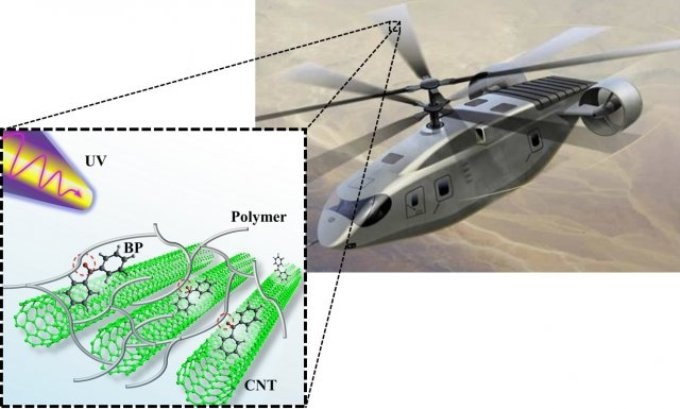Apr 19 2018
A technology that renders a composite material stronger and stiffer on-demand upon exposure to ultraviolet light has been developed by engineers at the U.S. Army Research Laboratory (ARL) and the University of Maryland.
 Army researchers imagine a rotorcraft concept, which represents reactive reinforcements that when exposed to ultraviolet light will increase the mechanical behavior on-demand. The engineers said control of mechanical behavior could potentially lead to increased aerodynamic stability in rotorcraft structures. (Image credit: U.S. Army illustration)
Army researchers imagine a rotorcraft concept, which represents reactive reinforcements that when exposed to ultraviolet light will increase the mechanical behavior on-demand. The engineers said control of mechanical behavior could potentially lead to increased aerodynamic stability in rotorcraft structures. (Image credit: U.S. Army illustration)
Such an on-demand control of composite behavior could make a range of innovative capabilities possible for future Army rotorcraft design, performance, and maintenance.
Dr. Frank Gardea, a research engineer at the ARL stated that the research centered on controlling the way molecules interacted with one another. He added that the goal was to “have them interact in such a way that changes at a small size, or nanoscale, could lead to observed changes at a larger size or macroscale.”
An important motivation for this work is the desire to engineer new structures, starting from the nanoscale, to enable advanced rotorcraft concepts that have been proposed in the past, but were infeasible due to limitations in current composites. One of the most important capabilities envisioned by these concepts is a significantly reduced maintenance burden due to compromises we make to fly at high speeds.
Dr Bryan Glaz, Chief Scientist of ARL’s Vehicle Technology Directorate
The reduction in the number of scheduled maintenance of future Army aviation platforms is a vital technological driver for impending operating concepts.
“The enhanced mechanical properties with potentially low weight penalties, enabled by the new technique, could lead to nanocomposite based structures that would enable rotorcraft concepts that we cannot build today,” stated Glaz.
The collaborative study was recently reported in the journal Advanced Materials Interfaces (DOI: 10.1002/admi.201800038) and demonstrates that these composite materials could become 35% stronger and 93% stiffer upon being exposed to ultraviolet light for five minutes.
The method involves attaching ultraviolet light reactive molecules to reinforcing agents such as carbon nanotubes. Then, the reactive reinforcing agents are embedded into a polymer. When exposed to ultraviolet light, a chemical reaction takes place, thereby increasing the interaction between the polymer and the reinforcing agents. This makes the material stronger and stiffer.
According to the team, the chemistry used here can be generally applied to a range of reinforcement/polymer combinations, thus widening the applicability of this control technique to a broad array of material systems.
“This research shows that it is possible to control the overall material property of these nanocomposites through molecular engineering at the interface between the composite components. This is not only important for fundamental science but also for the optimization of structural component response,” stated Dr Zhongjie Huang, a postdoctoral research fellow at the University of Maryland.
Army scientists devised this basic strategy for its capability of “enabling new leap-ahead capabilities in support of the Future Vertical Lift Army Modernization Priority,” officials stated.
“In this instance, the development of advanced structures to enable leap-ahead Army aviation capabilities not currently feasible due to limitations in mechanical properties of current materials,” stated Glaz. “This is especially important for the envisioned future operating environment which will require extended periods of operation without the opportunity to return to stationary bases for maintenance.”
Certain specifically attractive design options that relate to lower vibration and mechanical loads are not realizable at present owing to restrictions in structural damping in hingeless blade or wing structures.
Future structures built based on this study might result in the development of innovative composites with low weight and controlled structural damping that could ensure low-maintenance, high-speed rotorcraft concepts that cannot be achieved at present (e.g. soft in-plane tiltrotors).
Moreover, the controllable mechanical response will enable the design of adaptive aerospace structures that could prospectively accommodate mechanical loading conditions.
“The Army Research Laboratory and its partners will continue to invest in emerging and Soldier-inspired technologies that will enable more reliable, higher performing and leap-ahead capabilities that are key to the advancement of the next generation platforms used by Soldiers,” stated Elias Rigas, division chief of the ARL Vehicle Applied Research Division.
A partnership between the ARL and the University of Maryland played a vital role in developing this technology.
“In our lab at UMD we have been developing unique carbon nanomaterials and chemistry but it was not until Gardea approached us did we become aware of the intriguing challenge and opportunity for reconfigurable composite materials,” stated Dr. YuHuang Wang, professor of the Department of Chemistry and Biochemistry at the University of Maryland.
“Together we have achieved something that is quite remarkable.”